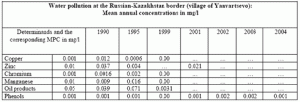|
On the territory of the Russian Federation, major pollution sources are the industrial
enterprises in Magnitogorsk and the Orenburg oblasts. In Kazakhstan, the cities of Uralsk and
Atyrau discharge municipal wastewaters with nutrients and organic substances into the Ural
River. Other pollution sources include surface water runoff, particularly during flood periods,
carrying away pollutants from sewage infiltration fields, as well as seepage from sewage ponds.
Surface runoff from the oil extraction sites on the Caspian coast (Tengiz, Prorva, Martyshi,
Kalamkas, Karazhmbas) introduces oil products into the Ural river.
Phenols, heavy metals and oil products are the principal pollutants in the Ural basin.
Data from 1990 to 1999 show that on the Russian-Kazakhstan border (village of Yanvartsevo)
the concentration of copper and phenol in the Ural River exceeded the maximum permitted
concentration (MPC) 5by a factor of 10 to12, whereas the concentrations for hexachlorane and
lindan were 1 to 18 times higher than the permissible concentrations. For the same period of
time, inputs of phosphorus and lindan from sources in Kazakhstan increased the pollution load
by 13% and 30%, respectively, compared to the measurement at the Russian/Kazakhstan border.
Despite the negative impact of floods, the diluting effects of huge spring
floods temporarily decrease water pollution in the river itself and allow for some self-purification
of the river system. These effects are particularly visible in the lower parts of the basin and in the
delta (see the table below). Nevertheless, data from the second half of the 1990s show a general
increase in the content of nitrogen compounds (by 3 times) and boron (by 7 times).

As indicated by the water pollution index, an increase of the overall pollution in the
1990s seems to be followed by a slight decrease of pollution from 2000 onwards and the
upgrading from water quality class 4 (polluted) to class 3 (moderately polluted). For individual
substance, a trend cannot be detected, as the factor by which the maximum allowable
concentration is exceeded considerably changes from year to year.
ECONOMIC COMMISSION FOR EUROPE
MEETING OF THE PARTIES TO THE CONVENTION ON THE PROTECTION AND USE OF TRANSBOUNDARY WATERCOURSES AND INTERNATIONAL LAKES
|





